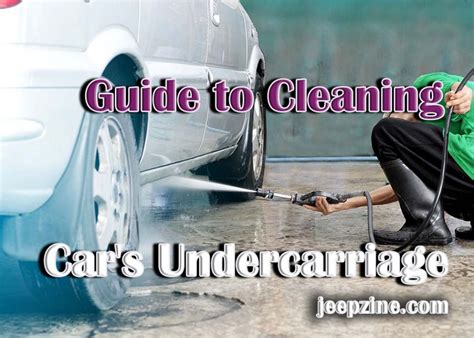How To Wash Car Undercarriage
Ronan Farrow
Apr 03, 2025 · 4 min read

Table of Contents
How to Wash Your Car's Undercarriage: A Comprehensive Guide
Maintaining a clean car is more than just a shiny exterior; it's about protecting your vehicle's longevity and value. While many focus on the body, neglecting the undercarriage can lead to rust, corrosion, and premature wear. This comprehensive guide will walk you through how to properly wash your car's undercarriage, protecting it from the elements and ensuring its long-term health.
Why Clean Your Car's Undercarriage?
Cleaning your car's undercarriage isn't just about aesthetics; it's crucial for preventative maintenance. Road salt, dirt, grime, and other debris accumulate on the undercarriage, accelerating corrosion and rust formation, especially in areas with harsh winters. Regular cleaning removes this buildup, protecting your vehicle's vital components.
Key Benefits of Undercarriage Cleaning:
- Prevent Rust and Corrosion: This is the most significant benefit. Road salt is a major culprit in rust formation, and cleaning helps neutralize its effects.
- Extend the Lifespan of Your Vehicle: By preventing rust and corrosion, you significantly extend the life of your car's chassis and other undercarriage components.
- Improve Fuel Efficiency: A buildup of dirt and debris can increase drag, slightly reducing your fuel efficiency. Cleaning helps maintain optimal airflow.
- Early Detection of Problems: Regular cleaning allows you to spot potential issues like leaks or damage early on, saving you money on repairs.
The Essential Tools and Materials
Before you begin, gather the necessary supplies:
- Pressure Washer: This is the most effective tool for cleaning the undercarriage. A pressure washer with adjustable pressure is ideal. Avoid using excessively high pressure, as it could damage delicate components.
- Garden Hose: Useful for pre-rinsing and final rinsing.
- Degreaser: A powerful degreaser is essential for breaking down stubborn grease and oil buildup. Choose a product specifically designed for automotive use.
- Car Wash Soap: Use a car wash soap specifically formulated for use with a pressure washer.
- Wheel Cleaning Brush: A long-handled brush is great for reaching those hard-to-reach spots.
- Various Cleaning Brushes: Brushes with different stiffnesses and shapes will help you clean various parts of the undercarriage.
- Safety Glasses: Protect your eyes from splashes.
- Gloves: Protect your hands from harsh chemicals.
- Jack and Jack Stands (Optional): For a more thorough cleaning, jacking up your car provides better access to the undercarriage. Always use jack stands for safety when working under your vehicle.
Step-by-Step Undercarriage Cleaning Process
-
Preparation is Key: Begin by pre-rinsing the entire undercarriage with a garden hose to remove loose dirt and debris. This prevents the pressure washer from spreading grime.
-
Apply Degreaser: Generously apply the degreaser to the entire undercarriage, paying particular attention to areas with heavy grease and oil buildup. Allow the degreaser to dwell for the time specified on the product's instructions.
-
Pressure Wash: Use the pressure washer to thoroughly rinse the undercarriage, starting from the top and working your way down. Use a sweeping motion and maintain a safe distance from the vehicle to avoid damaging any components. Adjust the pressure as needed for different areas. Focus on the areas with stubborn grime.
-
Scrubbing (Optional): For tough stains, use your brushes to scrub the affected areas. A long-handled brush is especially useful for hard-to-reach spots.
-
Final Rinse: Thoroughly rinse the entire undercarriage again with the pressure washer to remove all traces of degreaser and dirt. Follow up with a final rinse using the garden hose.
-
Drying (Optional): Allow the undercarriage to air dry completely or gently dry it off with a clean cloth or microfiber towel.
-
Post-Cleaning Inspection: Once the undercarriage is dry, take a moment to visually inspect it for any damage, leaks, or other issues.
Maintaining a Clean Undercarriage
Cleaning your car's undercarriage is not a one-time task; regular maintenance is essential for long-term protection. Aim to clean it every 2-3 months, or more frequently if you frequently drive in harsh conditions. Consider more frequent cleaning during winter months to remove corrosive road salt.
By following these steps, you can effectively clean your car's undercarriage, preventing rust, corrosion, and keeping your vehicle in top shape for years to come. Remember safety first – always wear appropriate safety gear and prioritize your safety when working under your vehicle.
Featured Posts
Also read the following articles
| Article Title | Date |
|---|---|
| How To Winterize A Hayward Pool Heater | Apr 03, 2025 |
| How To Whiten Skulls Without Peroxide | Apr 03, 2025 |
| Can Kindle Tell Me How Fast I Read | Apr 03, 2025 |
| How To Use Wooden Wicks | Apr 03, 2025 |
| How To Wear Black Leather Leggings | Apr 03, 2025 |
Latest Posts
-
How Big Of A Pool Pillow Do I Need
Apr 03, 2025
-
How Big Of A Patio Umbrella Do I Need
Apr 03, 2025
-
How Big Of A Camper Can An F150 Pull
Apr 03, 2025
-
How Big Of A Boat Can I Drive
Apr 03, 2025
-
How Big Of A Blackstone Do I Need
Apr 03, 2025
Thank you for visiting our website which covers about How To Wash Car Undercarriage . We hope the information provided has been useful to you. Feel free to contact us if you have any questions or need further assistance. See you next time and don't miss to bookmark.
